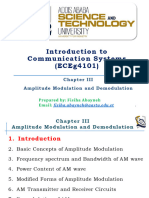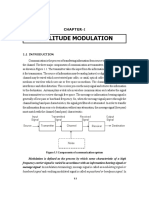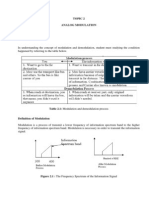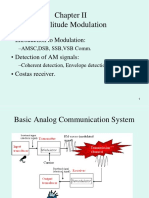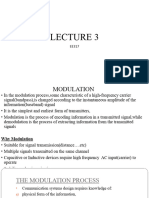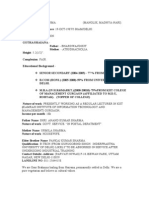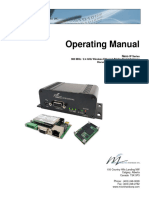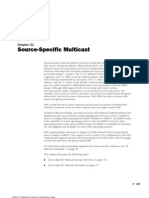0% found this document useful (0 votes)
177 views17 pagesModulation: By-Sanjay Kumar 0900321088 EN-2 (A)
Modulation is the process of varying a carrier signal in accordance with a modulating signal to transmit information. There are two main types of modulation: analog and digital. Analog modulation varies either the amplitude, frequency, or phase of an analog carrier signal with an analog modulating signal. Digital modulation varies a property of an analog carrier using a digital modulating signal. Amplitude modulation (AM) varies the amplitude of the carrier proportionally to the modulating signal. It is the simplest form of modulation and was used early for radio broadcasting. The modulation index indicates the degree of modulation and is the ratio of the modulating amplitude to the carrier amplitude.
Uploaded by
Shikha SharmaCopyright
© Attribution Non-Commercial (BY-NC)
We take content rights seriously. If you suspect this is your content, claim it here.
Available Formats
Download as PPT, PDF, TXT or read online on Scribd
0% found this document useful (0 votes)
177 views17 pagesModulation: By-Sanjay Kumar 0900321088 EN-2 (A)
Modulation is the process of varying a carrier signal in accordance with a modulating signal to transmit information. There are two main types of modulation: analog and digital. Analog modulation varies either the amplitude, frequency, or phase of an analog carrier signal with an analog modulating signal. Digital modulation varies a property of an analog carrier using a digital modulating signal. Amplitude modulation (AM) varies the amplitude of the carrier proportionally to the modulating signal. It is the simplest form of modulation and was used early for radio broadcasting. The modulation index indicates the degree of modulation and is the ratio of the modulating amplitude to the carrier amplitude.
Uploaded by
Shikha SharmaCopyright
© Attribution Non-Commercial (BY-NC)
We take content rights seriously. If you suspect this is your content, claim it here.
Available Formats
Download as PPT, PDF, TXT or read online on Scribd
/ 17

















